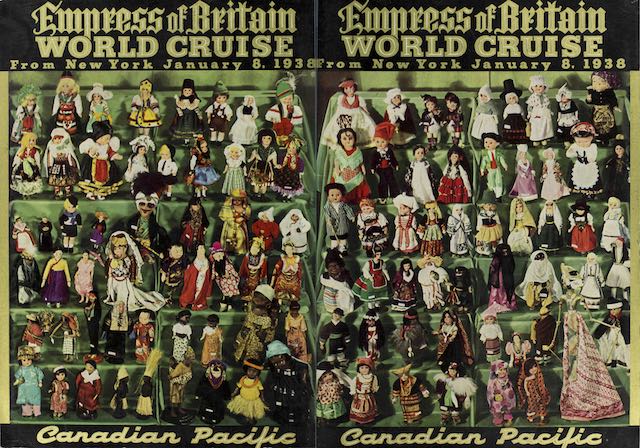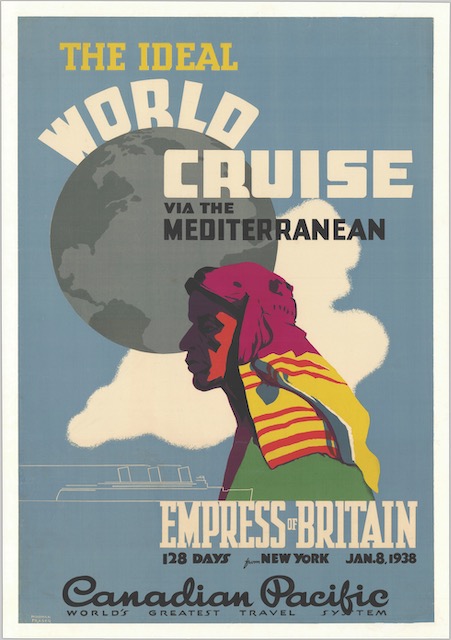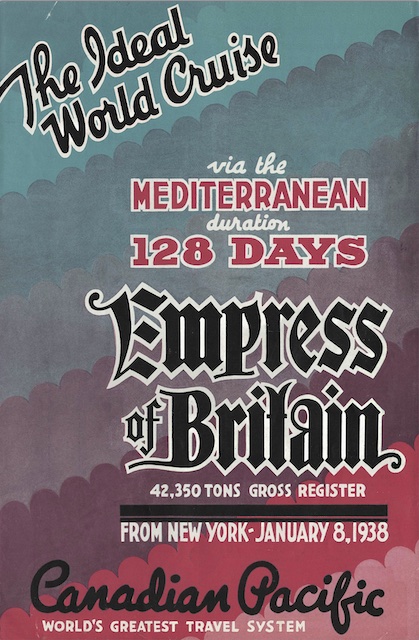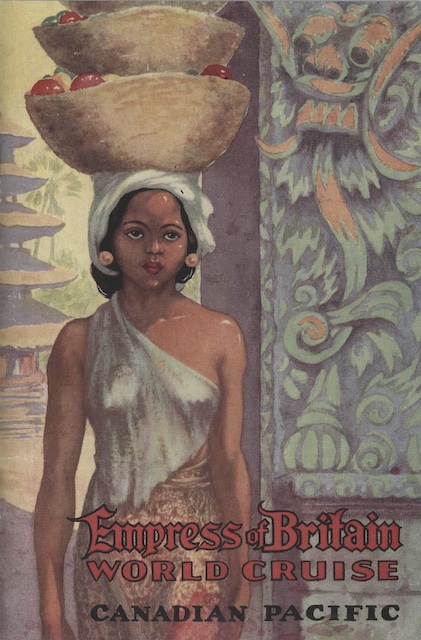Canadian Pacific’s 1938 world cruise was also its last true round-the-world cruise. It was 128 days long, three days longer than in 1937. Hilo and Havana were still off the itinerary, as in 1937, but the stay in Los Angeles had been extended from one day to two days and one night.
 Click image to view and download a 98.8-MB PDF of this booklet from the University of British Columbia Chung collection, which also has a brief brochure advertising the cruise.
Click image to view and download a 98.8-MB PDF of this booklet from the University of British Columbia Chung collection, which also has a brief brochure advertising the cruise.
The cover of the booklet advertising the cruise features more than 100 dolls dressed in exotic clothes supposedly reminiscent of the places that would be visited on the cruise. Some of the dolls are dressed in Dutch, German, and Scottish styles even though the cruise didn’t visit those countries.
What’s more notable is that this is a color photograph instead of a painting as was used on previous booklets. This is no doubt a result of the development of Kodachrome film, which was introduced for 35-mm cameras in 1936. Canadian Pacific was an early adapter of color photographs in its advertising.
 Click image to view and download a 5.1-MB PDF of this poster from the University of British Columbia Chung collection.
Click image to view and download a 5.1-MB PDF of this poster from the University of British Columbia Chung collection.
Here’s a poster advertising the 1938 world cruise illustrated by Norman Fraser, who may have been Canadian Pacific’s most prolific poster artist. Despite this, the authors of two books on Canadian Pacific posters were unable to find any information about Fraser other than he must have lived in Montreal from 1930 to 1953, when he was making posters for the railway. “I couldn’t find a trace of information on him in the CP archives,” says Marc Choko, one of the authors. This sounds so mysterious it makes me wonder if Norman Fraser wasn’t really a pseudonym for some other artist.
 Click image to view and download a 10.6-MB PDF of this booklet from the University of British Columbia Chung collection.
Click image to view and download a 10.6-MB PDF of this booklet from the University of British Columbia Chung collection.
Despite the drop in passengers in 1937, fares for the 1938 cruise remained unchanged. The number of passengers increased a little, from 294 to 307, but nowhere close to the 414 passengers carried in 1936.
 Click image to view and download a 7.8-MB PDF of this booklet from the University of British Columbia Chung collection.
Click image to view and download a 7.8-MB PDF of this booklet from the University of British Columbia Chung collection.
The passenger list included several members of fast-disappearing royal houses of Europe. First was Prince Andrew of Greece, the father of Prince Philip, who later married Princess Elizabeth of the United Kingdom. In 1938 Andrew was estranged from his wife, Princess Alice; her story was briefly told in the recent television series, The Crown.
In addition, the cruise hosted the three children of Prince Alexander (Alessandro), who was born to a royal house in Bohemia, part of the Austro-Hungary empire, and when he moved to Italy (which was also once part of the same empire) was made the Duke of Castel Duino. His three children included Prince Raymond (Raimundo), who inherited the ducal title when Alexander died in 1937, along with Prince Louis (Luigi) and Princess Margaret (Margarete). The three were no doubt acquainted with Prince Andrew as Prince Raymond would marry Prince Andrew’s niece in 1949.
Also on the cruise was Frances (Fanny) Goodyear, the granddaughter of New York industrialist Charles Goodyear. Fanny was accompanying her mother Jeanette. Prince Louis and Fanny married in 1939, and it is possible they met on this cruise.
Another cruise member is listed as Baroness F. Sybil Carbonelli. I can’t find much about her on the internet, but as near as I can tell, she was born Florence King in Pennsylvania in 1903, went through several husbands, from one of which she somehow acquired the title of baroness, and died in Florida in 1964.
Another American socialite who gained a title by married a broke European royal was Olive Elizabeth Perkins, who is listed in this booklet as Marchesa Olive Perkins D’Amico. She had married Marquis Stefano D’Amico of Milan, Italy, but had legally separated from him before this cruise.
